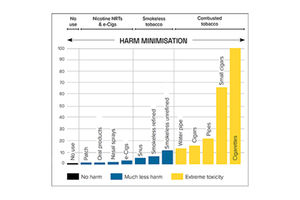
High Court lifts an order suspending licenses and import clearances relating to the manufacture, importation, distribution or sale of nicotine and related products.
When Mercy Wangeci (not her real name) first tried a nicotine pouch in her university hostel four years ago, it was meant to be a trendy experiment to fit in with her friends and just a bit of ‘fun’.
Today, at 24, she is deep in addiction, spending up to Sh12,000 a month on pouches that were outlawed years ago.
“It started with the hype. I did not want to be the odd one out. I bought a sachet of nicotine pouches for Sh250, and it would last three days. After the ban, we still had ‘plugs’ who got them, but now I pay Sh1,500 per can. They come in different brand names and strengths,” she says.

One in 17 students reported vaping nicotine in the past month, while one in 24 had used nicotine pouches, products widely criticised for their deceptive marketing aimed at youth.
Despite the government’s crackdown on harmful nicotine products, Mercy says these pouches remain widely available, just less visible.
“You have to know the right people. But they are everywhere. I know I am addicted. I don’t even know how to quit,” she adds.
She is not alone.
*Kelvin Langat, 28, vapes multiple times a day. Drawn in by sleek devices, sweet flavours and peer influence, what began as an occasional puff has now become part of his daily routine.
“At first, it felt harmless, just vapour and flavour. But now, I vape the moment I wake up, and again during the day, especially when I am out with friends,” he says.
Kelvin spends up to Sh5,000 a month on vape pods and liquids. He admits to experiencing chest tightness and fatigue but is not ready to quit. “It doesn’t feel that serious, but I know it is affecting my health,” he says.

Kenya continues to combat tobacco use.
Both Mercy and Kelvin are among a growing number of young Kenyans who have become hooked on new-age nicotine products. These products, ranging from vapes to pouches, are all aggressively marketed despite regulatory bans.
As Kenya joins the global community in marking World No Tobacco Day 2025 under the theme “Unmasking the Appeal: Exposing Industry Tactics on Tobacco and Nicotine Products”, the Ministry of Health has reiterated its call for sustained vigilance.
Health Cabinet Secretary Aden Duale said that Kenya remains alert to the tobacco industry’s increasingly deceptive strategies, particularly those targeting young people.
“The health of our future generations depends on our ability to expose and counter the tobacco industry’s predatory strategies,” he said.
This year’s theme sheds light on the manipulative approaches used by tobacco and nicotine manufacturers, including the promotion of attractive products, eye-catching packaging, and intensified digital marketing campaigns, all aimed at enticing the youth.
In response, Kenya has maintained a firm stance through evidence-based policies, community engagement, and strong inter-agency coordination.
“We are united in unmasking and dismantling these manipulative tactics, especially those that prey on our youth. Tobacco control is not just a health priority but a national development imperative,” CS Duale said.
Kenya’s progress in reducing tobacco consumption over the years is noteworthy. Data from the 2022 Tobacco and Drug Abuse Survey reveals that tobacco use among adults aged 15 to 65 has declined to 8.5 per cent, down from 11.6 per cent in 2014.
This decline is attributed to sustained policy interventions, including increased taxation, which has made tobacco products less affordable, especially to young people. Additionally, there has been a 15 per cent reduction in smoking initiation among adolescents since 2020.
At the grassroots level, the Tobacco-Free Farms Initiative has empowered farmers in Meru, Migori, Bungoma, and Busia counties to transition from tobacco farming to alternative sustainable livelihoods, thereby reducing the tobacco supply chain. Over 650,000 adolescents aged 10 to 17 in Kenya are said to have experimented with tobacco or nicotine products.

Smoking liquids and vapes.
In response to emerging threats, the Ministry of Health has strengthened Kenya’s tobacco control framework over the past year. Key interventions include a national strategy focused on new tobacco and nicotine products, stricter regulations, and more targeted public education campaigns.
The ongoing review of the Tobacco Control Act (2007) is currently undergoing stakeholder validation to enhance legislative measures.
In December 2024, a landmark ruling by the Court of Appeal upheld the national ban on shisha, reinforcing public health protections.
Enforcement operations have also intensified, with coordinated night raids in April 2025 leading to the seizure of illicit nicotine pouches and other illegal tobacco products.
The Ministry vows to sustain these efforts across major urban centres nationwide.
A recent study by the National Authority for the Campaign Against Alcohol and Drug Abuse (Nacada) has revealed an alarming trend. Nearly half of university students in Kenya have experimented with drugs or alcohol, with tobacco and nicotine products often serving as a gateway to addiction.
Titled Status of Drugs and Substance Use Among University Students in Kenya, the report sheds light on an industry increasingly targeting youth, as mental health challenges and substance dependence rise sharply.
Based on a survey of 15,678 students across 17 public and private universities, the study found that 45.6 per cent had used at least one substance in their lifetime, and 26.6 per cent were current users.
While alcohol, tobacco, khat (miraa), muguka and cannabis (bhang) remain the most commonly used substances, emerging threats such as vapes, nicotine pouches, and cannabis edibles are quickly gaining popularity.
Alarmingly, one in 17 students reported vaping nicotine in the past month, while one in 24 had used nicotine pouches, products widely criticised for their deceptive marketing aimed at youth.
“Products such as flavoured vapes and discreet nicotine pouches are often promoted as safer alternatives, obscuring their highly addictive nature. These products are deliberately designed to hook young users early,” Nacada warned, noting that 20.4 per cent of students had tried tobacco products.

A set of multicolour disposable electronic cigarettes.
Substance use was notably higher in private universities, where 35 per cent of students reported monthly use, compared to 22.6 per cent in public institutions.
Without intervention, Nacada warns of a “lost generation” grappling with addiction, mental illness, and stunted potential.
The World Health Organization (WHO) has highlighted concerning global trends in youth tobacco and nicotine use. In 2024, the WHO released the Global Report on Trends in Prevalence of Tobacco Use 2000–2030, which shows a decrease in global tobacco users from 1 in 3 people in 2000 to 1 in 5 in 2022.
Despite this overall decline, surveys from many countries consistently reveal that children aged 13 to 15 continue to use tobacco and nicotine products.
Approximately 37 million children in this age group currently use tobacco products worldwide. In many countries, the prevalence of e-cigarette use among adolescents now exceeds that of adults.
The WHO attributes this rise to the tobacco and nicotine industry's strategic marketing tactics, including the promotion of attractive products, eye-catching packaging, and intensified digital marketing campaigns specifically aimed at enticing young people.
These manipulative approaches are designed to create a new generation of nicotine-dependent individuals.
In response to these challenges, the WHO urges governments to implement stringent regulations to protect young people from the uptake of tobacco, e-cigarettes, and other nicotine products.
In Kenya, the Ministry of Health has echoed these concerns, emphasising the need for sustained vigilance in the fight against tobacco use and the harmful tactics employed by the tobacco industry.
The country has made significant progress in reducing tobacco consumption through evidence-based policies, community engagement, and strong inter-agency coordination.
A nationwide public education campaign implemented between November 2024 and February 2025 covered all 47 counties. Organised into 10 regional clusters and supported by partners such as the International Institute for Legislative Affairs (ILA) and the Kenya Tobacco Control Alliance (KETCA), the campaign reached a wide audience, bolstering public awareness.
The rollout of seventeen new graphic health warnings on tobacco packaging further strengthens Kenya’s health communication efforts. The Tobacco-Free Farms Initiative has also expanded its reach, with an increasing number of farmers adopting sustainable alternatives to tobacco cultivation.
The Ministry of Health has also completed the design of prototype integrated outpatient cessation centres and conducted readiness assessments in Mombasa, Kisumu, Machakos, Kakamega, Kericho, Nakuru, Meru and Garissa counties, in preparation for a national cessation programme.
Strategic partnerships with institutions such as the Kenya Medical Research Institute have enhanced data-driven policymaking, enabling the ministry to adapt interventions effectively in real time.
In addition, collaboration with the National Treasury has resulted in higher taxes on tobacco and nicotine products, initiatives that have contributed to reduced consumption, while generating vital revenue to support health programmes.
As Kenya continues to combat tobacco use, the Ministry of Health calls on all stakeholders—government agencies, civil society, communities, and individuals—to remain vigilant and united in protecting the nation’s health and future






